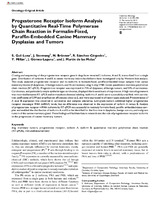Mostrar el registro sencillo del ítem
Progesterone Receptor Isoform Analysis by Quantitative Real-Time Polymerase Chain Reaction in Formalin-Fixed, Paraffin-Embedded Canine Mammary Dysplasias and Tumors
| dc.contributor.author | Guil-Luna, Silvia | |
| dc.contributor.author | Stenvang, Jan | |
| dc.contributor.author | Brünner, Nils | |
| dc.contributor.author | Sánchez Céspedes, Raquel | |
| dc.contributor.author | Millán, Yolanda | |
| dc.contributor.author | Gómez-Laguna, J. | |
| dc.contributor.author | Martín de las Mulas González-Albo, Juana | |
| dc.date.accessioned | 2024-02-04T21:36:56Z | |
| dc.date.available | 2024-02-04T21:36:56Z | |
| dc.date.issued | 2014 | |
| dc.identifier.issn | 03009858 | |
| dc.identifier.uri | http://hdl.handle.net/10396/27064 | |
| dc.description.abstract | Cloning and sequencing of the progesterone receptor gene in dogs have revealed 2 isoforms, A and B, transcribed from a single gene. Distribution of isoforms A and B in canine mammary lesions has hitherto been investigated only by Western blot analysis. This study analyzed progesterone receptor and its isoforms in formalin-fixed, paraffin-embedded tissue samples from canine mammary lesions (4 dysplasias, 10 benign tumors, and 46 carcinomas) using 1-step SYBR Green quantitative real-time polymerase chain reaction (RT-qPCR). Progesterone receptor was expressed in 75% of dysplasias, all benign tumors, and 59% of carcinomas. Carcinomas, and particularly simple epithelial-type carcinomas, displayed the lowest levels of expression. A high rate of agreement was recorded between RT-qPCR and immunohistochemical labeling. Isoforms A and B were successfully amplified, with correlation coefficients of 0.99 and amplification efficiencies close to 2, and were expressed in all lesion types analyzed. Predominance of A over B expression was observed in carcinomas and complex adenomas. Low-grade tumors exhibited higher progesterone receptor messenger RNA (mRNA) levels, but no difference was observed in the expression of isoform A versus B. Analysis of progesterone receptor mRNA isoforms by RT-qPCR was successful in routinely formalin-fixed, paraffin-embedded tissue samples and enabled the distribution of isoforms A and B to be identified for the first time in dysplasias, benign tumors, and malignant tumors of the canine mammary gland. These findings will facilitate future research into the role of progesterone receptor isoforms in the progression of canine mammary tumors. | es_ES |
| dc.format.mimetype | application/pdf | es_ES |
| dc.language.iso | eng | es_ES |
| dc.publisher | Sage | es_ES |
| dc.rights | https://creativecommons.org/licenses/by-nc-nd/4.0/ | es_ES |
| dc.source | Guil-Luna S, Stenvang J, Brünner N, et al. Progesterone Receptor Isoform Analysis by Quantitative Real-Time Polymerase Chain Reaction in Formalin-Fixed, Paraffin-Embedded Canine Mammary Dysplasias and Tumors. Veterinary Pathology. 2014;51(5):895-902 | es_ES |
| dc.subject | Dog | es_ES |
| dc.subject | Mammary tumors | es_ES |
| dc.subject | Progesterone receptor | es_ES |
| dc.subject | Isoform A | es_ES |
| dc.subject | Isoform B | es_ES |
| dc.subject | Quantitative real-time polymerase chain reaction (RT-qPCR) | es_ES |
| dc.subject | Immunohistochemistry | es_ES |
| dc.title | Progesterone Receptor Isoform Analysis by Quantitative Real-Time Polymerase Chain Reaction in Formalin-Fixed, Paraffin-Embedded Canine Mammary Dysplasias and Tumors | es_ES |
| dc.type | info:eu-repo/semantics/article | es_ES |
| dc.relation.publisherversion | http://dx.doi.org/10.1177/0300985813511127 | es_ES |
| dc.relation.projectID | AGL2011-25553 | es_ES |
| dc.rights.accessRights | info:eu-repo/semantics/openAccess | es_ES |

